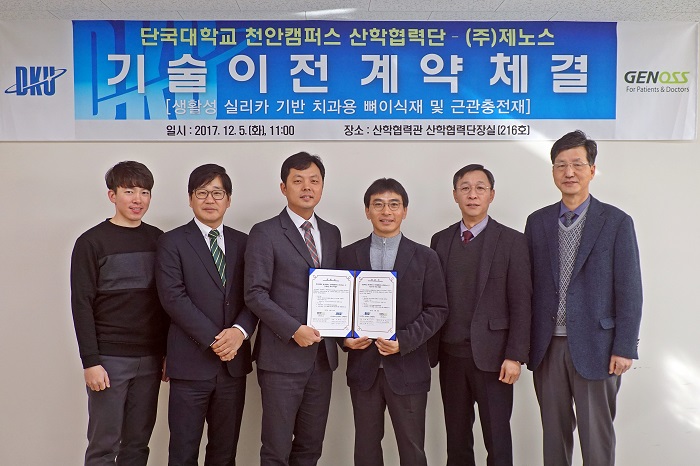The Industry-Academia Cooperation Foundation at Dankook University’s Cheonan campus signed a technology transfer agreement with Genoss Co., Ltd. for the ‘development of medical devices for hard tissue regeneration using bioactive silica.’
The technology provided by Dankook to Genoss is a core technology in developing bioactive root canal sealers that significantly improve the regeneration ability of bone graft material used in dental implants. Genoss plans to leverage this technology to launch a new product over the next two years.
To this end, two patented technologies and the technological knowhow jointly developed by professors Haewon Kim and Hae-Hyoung Lee, along with professor Jonathan Campbell Knowles of the University of London’s Eastman Dental Institute will be transferred to Genoss. In return, the company will pay 100 million KRW in royalties and 3% of its revenues annually following the introduction of the new product.

Professor Kim said that “the technology is expected to be used in developing a dental regeneration material that responds more actively to our body and nervous system to accelerate the pace of safe tissue regeneration compared to existing bone grafting material.”
Meanwhile, Dankook University and Genoss were selected for the ‘Project to establish and operate a joint research entity in the science belt functional district’ by the Ministry of Science and ICT. Through this project, Genoss and ITREN (Institute of Tissue Regeneration Engineering) will establish a joint research entity named ‘Gentren’ and embark on a joint industry-academia research project with the support of government funding worth approximately 1 billion KRW over the course of two years.
Professor Haewon Kim, who is the chief director in charge of the technology development, says that “having the research outcome of our university, commercialized and used in products through technology transfer will serve as a meaningful example of industry-academia partnerships. We also look forward to the partner companies developing new products that can be differentiated from those of their competitors, develop new markets at home and abroad, and create new jobs and revenue growth.”